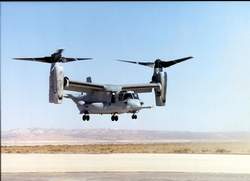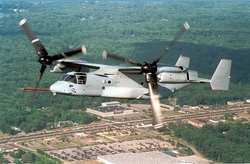MV-22 Osprey Is Safest Marine Corps Rotorcraft Over Past 10
Years
The Naval Air Systems Command (NAVAIR) V-22 Joint Program Office
(PMA-275) said this week that the Bell Boeing-built V-22 Osprey
fleet has surpassed 100,000 flight hours.

The milestone was reached on Feb. 10 during a U.S. Marine Corps
MV-22 Osprey combat mission in Afghanistan. Marine Medium Tiltrotor
Squadron 264, currently operating out of Camp Bastion in Helmand
Province, was identified as the squadron that eclipsed the
100,000-hour mark. "The entire Bell Boeing tiltrotor team
congratulates our Marine Corps and Air Force Special Operations
Command (AFSOC) customers on achieving 100,000 flight hours, and
counting," said John Rader, executive director of the Bell Boeing
V-22 Program. "The performance of the aircraft in combat and
humanitarian missions has been truly remarkable. We continue to
take great pride in providing our customers with this revolutionary
capability."
Marine Corps MV-22 and AFSOC CV-22 Ospreys amassed the flight
hours while performing combat, humanitarian, training, and test and
evaluation missions. Almost half of the total hours were flown
during the past two years. This milestone marks the latest major
achievement for a program that has seen 14 successful combat and
humanitarian deployments since the Osprey was first declared
operational in 2007. "The V-22 is proven and forward-deployed,
supporting combat operations and responding to contingency
operations around the world," said Marine Corps Col. Greg Masiello,
head of the V-22 Joint Program Office (PMA-275) at NAVAIR. "The
Osprey brings unprecedented range, speed and survivability to the
warfighter and will continue to excel in combat and remain ready,
effective and survivable."

According to Naval Safety Center records, the MV-22 has had the
lowest Class A mishap rate of any rotorcraft in the Marine Corps
during the past decade. The aircraft's reduced susceptibility,
lower vulnerability and advanced crashworthiness have made it the
most survivable military rotorcraft ever introduced. Fiscal Year
2010 Navy flight-hour cost data also show that the Osprey has the
lowest cost per seat-mile (cost to transport one person over a
distance of one mile) of any U.S. Navy transport rotorcraft. "At
100,000 flight hours, safety, survivability and mission efficiency
have become hallmarks of the operational fleet," said Mitch Snyder,
deputy program director for the Bell Boeing V-22 Program.
In a related development, the aircraft is set to be fitted with
a defensive weapon system developed over the last four years by
BAE, which is based on the company’s Remote Guardian System
(RGS), a remotely operated defensive weapon system that provides
360° of suppressive weapons fire for the V-22.

The RGS system is a common airborne defensive capability.
Designed to be belly-mounted on the V-22, BAE says it is the first
remote weapon system capable of delivering accurate, sustained fire
throughout the aircraft’s flight envelope. It features a
compact, retractable design that saves valuable aircraft cabin
space and is compatible with the full complement of the
V-22’s avionics suite. “This system will provide vital
protection to the V-22, its operators, and the Marines it will
carry,” said Jim Garceau, vice president of defense avionics
for BAE Systems. “The weapon system’s accuracy and
ability to lock onto a stationary target in flight are critical to
the defense of the aircraft.”
Under the $14 million contract, which calls for a belly-mounted,
all quadrant defensive weapon capability for the Osprey, BAE
Systems will produce and support RGS defensive weapon systems to be
delivered by the end of 2012. The contract also includes a $12
million exercisable option for additional systems and support.
 ANN's Daily Aero-Term (05.09.24): Hold Procedure
ANN's Daily Aero-Term (05.09.24): Hold Procedure ANN's Daily Aero-Term (05.06.24): Altitude Readout
ANN's Daily Aero-Term (05.06.24): Altitude Readout ANN's Daily Aero-Linx (05.06.24)
ANN's Daily Aero-Linx (05.06.24) Airborne-NextGen 05.07.24: AI-Piloted F-16, AgEagle, 1st 2 WorldView Sats
Airborne-NextGen 05.07.24: AI-Piloted F-16, AgEagle, 1st 2 WorldView Sats Aero-News: Quote of the Day (05.07.24)
Aero-News: Quote of the Day (05.07.24)




